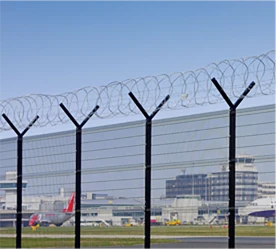The Concept of Sound Reflecting Fences An Innovative Approach to Noise Management
Noise pollution is an ever-increasing problem in our modern world, particularly in urban areas where the cacophony of traffic, construction, and other activities can significantly disrupt the quality of life. To combat this issue, various solutions have been proposed, one of which is the concept of sound reflecting fences. These structures not only serve as barriers to sound but also integrate architectural and environmental considerations.
Understanding Sound Reflecting Fences
Sound reflecting fences are designed to redirect and manage sound waves rather than absorb them. Traditional noise barriers, which are often used along highways or near industrial areas, typically aim to minimize noise by absorbing sound or diffusing it into the environment. In contrast, sound reflecting fences utilize materials that bounce sound waves back, effectively deflecting noise from sensitive areas, such as residential neighborhoods or recreational zones.
The rationale behind this design stems from the principles of acoustics. Sound waves travel in all directions, and when they encounter a barrier, they can either be absorbed, transmitted, or reflected. Sound reflecting fences optimize the reflection of sound waves away from populated areas, reducing the overall noise levels experienced by individuals living nearby.
Construction and Materials
The construction of sound reflecting fences requires careful consideration of materials and design. Typically, these fences are made from hard, dense materials such as concrete, metal, or specially designed composites that can effectively reflect sound. Additionally, the height and angle of the fence play critical roles in determining its effectiveness. Taller fences can block lower frequency sounds which tend to travel more easily, while strategically angled surfaces can further enhance reflection.
Design also plays a crucial role in the aesthetics and functionality of these fences. Modern sound reflecting fences can be integrated into urban landscapes without compromising the visual appeal of an area. Artistic designs, greenery integration, and technology can be employed to create barriers that are not only effective but also visually pleasing.
Environmental Impact
sound reflecting fence

The use of sound reflecting fences has implications beyond just noise reduction. They can contribute to environmental sustainability by serving as wildlife corridors or green spaces, helping to maintain biodiversity in urban settings. By incorporating plants and living walls, these structures can improve air quality and provide habitats for various species.
Additionally, effective noise management can enhance the living environment, encouraging people to spend more time outdoors and engage with their communities. Quiet neighborhoods have been shown to foster better mental health and overall well-being, making sound reflecting fences not just a technical solution but a holistic approach to urban planning.
Case Studies and Applications
There are successful examples around the world where sound reflecting fences have been implemented. In cities like Los Angeles and London, innovative acoustic barriers have significantly reduced noise levels in residential districts adjacent to busy highways. These projects have led to improvements in community satisfaction and have opened pathways for more sustainable urban developments.
In addition to highways, sound reflecting fences have been used effectively in noise-sensitive areas such as parks near airports or stadiums. By reflecting sound away from sensitive locations, communities can celebrate progress in transportation and entertainment without sacrificing peace and tranquility.
Conclusion
As noise pollution continues to pose a challenge in urban settings, the concept of sound reflecting fences represents a promising avenue for innovative urban design. These structures not only address the urgent need for noise management but also promote sustainable development, enhancing the quality of life for residents.
By embracing this multifaceted approach, cities can evolve to become quieter and more livable, ensuring that they remain vibrant spaces for generations to come. The implementation of sound reflecting fences may indeed symbolize a shift towards a more harmonious coexistence between urban life and the natural environment, echoing the need for solutions that are both practical and aesthetically integrated into the urban landscape.
-
The Strength and Versatility of Aluminum Expanded Metal Mesh
NewsJun.10,2025
-
Safety Guards and Machine Enclosures Using Expanded Mesh
NewsJun.10,2025
-
Performance with Round Hole Perforated Mesh in Wall Panels
NewsJun.10,2025
-
How Steel Grating Trench Covers Distribute Weight Efficiently
NewsJun.10,2025
-
How Deck Mesh Railing Enhances Backyard Aesthetics
NewsJun.10,2025
-
Comparing Bar Thickness and Spacing in Steel Grating
NewsJun.10,2025
Subscribe now!
Stay up to date with the latest on Fry Steeland industry news.

